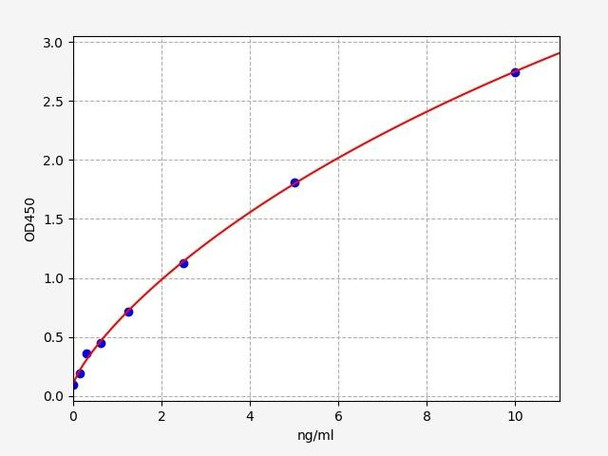Mouse Glutathione Peroxidase 2/GPX2 ELISA Kit (MOFI00423)
- SKU:
- MOFI00423
- Product Type:
- ELISA Kit
- Size:
- 96 Assays
- Uniprot:
- Q9JHC0
- Sensitivity:
- 0.094ng/ml
- Range:
- 0.156-10ng/ml
- ELISA Type:
- Sandwich
- Synonyms:
- Gpx2, Glutathione peroxidase 2, GPx-2, GSHPx-2, Glutathione peroxidase-related protein 2, GPRP-2, Gastrointestinal glutathione peroxidase, Glutathione peroxidase-gastrointestinal, GPx-GI, GSHPx-GI
- Reactivity:
- Mouse
Description
Mouse Glutathione Peroxidase 2/GPX2 ELISA Kit
The Mouse Glutathione Peroxidase 2 (GPX2) ELISA Kit is a highly sensitive and specific assay designed for the accurate detection of GPX2 levels in mouse serum, plasma, and cell culture supernatants. This kit provides reliable and reproducible results, making it suitable for various research applications.GPX2 is an essential enzyme involved in protecting cells from oxidative stress by catalyzing the reduction of hydrogen peroxide and organic hydroperoxides. It plays a critical role in maintaining redox homeostasis and protecting cells from damage, making it a key player in various diseases such as cancer, inflammation, and metabolic disorders.
By accurately measuring GPX2 levels in biological samples, researchers can gain valuable insights into oxidative stress-related mechanisms and potentially develop novel therapeutic strategies. The Mouse GPX2 ELISA Kit offers a powerful tool for studying the function and regulation of this important enzyme in biological systems.
| Product Name: | Mouse Glutathione Peroxidase 2/GPX2 ELISA Kit |
| Product Code: | MOFI00423 |
| Size: | 96 Assays |
| Alias: | Gpx2, Glutathione peroxidase 2, GPx-2, GSHPx-2, Glutathione peroxidase-related protein 2, GPRP-2, Gastrointestinal glutathione peroxidase, Glutathione peroxidase-gastrointestinal, GPx-GI, GSHPx-GI |
| Detection Method: | Sandwich ELISA |
| Application: | This immunoassay kit allows for the in vitro quantitative determination of Mouse Gpx2 concentrations in serum plasma and other biological fluids. |
| Sensitivity: | 0.094ng/ml |
| Range: | 0.156-10ng/ml |
| Storage: | 4°C for 6 months |
| Note: | For Research Use Only |
| Recovery: | Matrices listed below were spiked with certain level of Mouse Gpx2 and the recovery rates were calculated by comparing the measured value to the expected amount of Mouse Gpx2 in samples. | ||||||||||||||||
| |||||||||||||||||
| Linearity: | The linearity of the kit was assayed by testing samples spiked with appropriate concentration of Mouse Gpx2 and their serial dilutions. The results were demonstrated by the percentage of calculated concentration to the expected. | ||||||||||||||||
| |||||||||||||||||
| Intra Assay: | CV <8% | ||||||||||||||||
| Inter Assay: | CV <10% |
| Component | Quantity | Storage |
| ELISA Microplate (Dismountable) | 8-12 strips | 4°C for 6 months |
| Lyophilized Standard | 2 | 4°C/-20°C |
| Sample/Standard Dilution Buffer | 20ml | 4°C |
| Biotin-labeled Antibody(Concentrated) | 120ul | 4°C (Protect from light) |
| Antibody Dilution Buffer | 10ml | 4°C |
| HRP-Streptavidin Conjugate(SABC) | 120ul | 4°C (Protect from light) |
| SABC Dilution Buffer | 10ml | 4°C |
| TMB Substrate | 10ml | 4°C (Protect from light) |
| Stop Solution | 10ml | 4°C |
| Wash Buffer(25X) | 30ml | 4°C |
| Plate Sealer | 5 | - |
Other materials and equipment required:
- Microplate reader with 450 nm wavelength filter
- Multichannel Pipette, Pipette, microcentrifuge tubes and disposable pipette tips
- Incubator
- Deionized or distilled water
- Absorbent paper
- Buffer resevoir
| Uniprot | Q9JHC0 |
| UniProt Protein Function: | GPX2: Could play a major role in protecting mammals from the toxicity of ingested organic hydroperoxides. Tert-butyl hydroperoxide, cumene hydroperoxide and linoleic acid hydroperoxide but not phosphatidycholine hydroperoxide, can act as acceptors. Belongs to the glutathione peroxidase family. |
| UniProt Protein Details: | Protein type:EC 1.11.1.9; Lipid Metabolism - arachidonic acid; Other Amino Acids Metabolism - glutathione; Oxidoreductase Chromosomal Location of Human Ortholog: 12 C3|12 33.73 cM Cellular Component: cytosol Molecular Function:glutathione peroxidase activity Biological Process: interaction with symbiont; negative regulation of inflammatory response to antigenic stimulus; response to symbiotic bacterium; thermoregulation |
| NCBI Summary: | The protein encoded by this gene belongs to the glutathione peroxidase family, members of which catalyze the reduction of organic hydroperoxides and hydrogen peroxide (H2O2) by glutathione, and thereby protect cells against oxidative damage. Several isozymes of this gene family exist in vertebrates, which vary in cellular location and substrate specificity. This isozyme is predominantly expressed in the gastrointestinal tract in rodents, is localized in the cytoplasm, and whose preferred substrate is hydrogen peroxide. Knockout studies in mice lacking this gene suggest a role for this isozyme in intestinal inflammation and colon cancer development. This isozyme is also a selenoprotein, containing the rare amino acid selenocysteine (Sec) at its active site. Sec is encoded by the UGA codon, which normally signals translation termination. The 3' UTRs of selenoprotein mRNAs contain a conserved stem-loop structure, designated the Sec insertion sequence (SECIS) element, that is necessary for the recognition of UGA as a Sec codon, rather than as a stop signal. A pseudogene of this gene has been identified on chromosome 7. [provided by RefSeq, Jul 2016] |
| UniProt Code: | Q9JHC0 |
| NCBI GenInfo Identifier: | 145275168 |
| NCBI Gene ID: | 14776 |
| NCBI Accession: | NP_109602.2 |
| UniProt Secondary Accession: | Q9JHC0,Q3V2B2, |
| UniProt Related Accession: | Q9JHC0 |
| Molecular Weight: | 21,990 Da |
| NCBI Full Name: | glutathione peroxidase 2 |
| NCBI Synonym Full Names: | glutathione peroxidase 2 |
| NCBI Official Symbol: | Gpx2 |
| NCBI Official Synonym Symbols: | GI-GPx; GPx-GI; GSHPx-2; GSHPx-GI |
| NCBI Protein Information: | glutathione peroxidase 2 |
| UniProt Protein Name: | Glutathione peroxidase 2 |
| UniProt Synonym Protein Names: | Glutathione peroxidase-gastrointestinal; GPx-GI; GSHPx-GI |
| Protein Family: | Glutathione peroxidase |
| UniProt Gene Name: | Gpx2 |
*Note: Protocols are specific to each batch/lot. For the correct instructions please follow the protocol included in your kit.
| Step | Procedure |
| 1. | Set standard, test sample and control (zero) wells on the pre-coated plate respectively, and then, record their positions. It is recommended to measure each standard and sample in duplicate. Wash plate 2 times before adding standard, sample and control (zero) wells! |
| 2. | Aliquot 0.1ml standard solutions into the standard wells. |
| 3. | Add 0.1 ml of Sample / Standard dilution buffer into the control (zero) well. |
| 4. | Add 0.1 ml of properly diluted sample (Human serum, plasma, tissue homogenates and other biological fluids.) into test sample wells. |
| 5. | Seal the plate with a cover and incubate at 37 °C for 90 min. |
| 6. | Remove the cover and discard the plate content, clap the plate on the absorbent filter papers or other absorbent material. Do NOT let the wells completely dry at any time. Wash plate X2. |
| 7. | Add 0.1 ml of Biotin- detection antibody working solution into the above wells (standard, test sample & zero wells). Add the solution at the bottom of each well without touching the side wall. |
| 8. | Seal the plate with a cover and incubate at 37°C for 60 min. |
| 9. | Remove the cover, and wash plate 3 times with Wash buffer. Let wash buffer rest in wells for 1 min between each wash. |
| 10. | Add 0.1 ml of SABC working solution into each well, cover the plate and incubate at 37°C for 30 min. |
| 11. | Remove the cover and wash plate 5 times with Wash buffer, and each time let the wash buffer stay in the wells for 1-2 min. |
| 12. | Add 90 µL of TMB substrate into each well, cover the plate and incubate at 37°C in dark within 10-20 min. (Note: This incubation time is for reference use only, the optimal time should be determined by end user.) And the shades of blue can be seen in the first 3-4 wells (with most concentrated standard solutions), the other wells show no obvious color. |
| 13. | Add 50 µL of Stop solution into each well and mix thoroughly. The color changes into yellow immediately. |
| 14. | Read the O.D. absorbance at 450 nm in a microplate reader immediately after adding the stop solution. |
When carrying out an ELISA assay it is important to prepare your samples in order to achieve the best possible results. Below we have a list of procedures for the preparation of samples for different sample types.
| Sample Type | Protocol |
| Serum: | If using serum separator tubes, allow samples to clot for 30 minutes at room temperature. Centrifuge for 10 minutes at 1,000x g. Collect the serum fraction and assay promptly or aliquot and store the samples at -80°C. Avoid multiple freeze-thaw cycles. If serum separator tubes are not being used, allow samples to clot overnight at 2-8°C. Centrifuge for 10 minutes at 1,000x g. Remove serum and assay promptly or aliquot and store the samples at -80°C. Avoid multiple freeze-thaw cycles. |
| Plasma: | Collect plasma using EDTA or heparin as an anticoagulant. Centrifuge samples at 4°C for 15 mins at 1000 - g within 30 mins of collection. Collect the plasma fraction and assay promptly or aliquot and store the samples at -80°C. Avoid multiple freeze-thaw cycles. Note: Over haemolysed samples are not suitable for use with this kit. |
| Urine & Cerebrospinal Fluid: | Collect the urine (mid-stream) in a sterile container, centrifuge for 20 mins at 2000-3000 rpm. Remove supernatant and assay immediately. If any precipitation is detected, repeat the centrifugation step. A similar protocol can be used for cerebrospinal fluid. |
| Cell culture supernatant: | Collect the cell culture media by pipette, followed by centrifugation at 4°C for 20 mins at 1500 rpm. Collect the clear supernatant and assay immediately. |
| Cell lysates: | Solubilize cells in lysis buffer and allow to sit on ice for 30 minutes. Centrifuge tubes at 14,000 x g for 5 minutes to remove insoluble material. Aliquot the supernatant into a new tube and discard the remaining whole cell extract. Quantify total protein concentration using a total protein assay. Assay immediately or aliquot and store at ≤ -20°C. |
| Tissue homogenates: | The preparation of tissue homogenates will vary depending upon tissue type. Rinse tissue with 1X PBS to remove excess blood & homogenize in 20ml of 1X PBS (including protease inhibitors) and store overnight at ≤ -20°C. Two freeze-thaw cycles are required to break the cell membranes. To further disrupt the cell membranes you can sonicate the samples. Centrifuge homogenates for 5 mins at 5000xg. Remove the supernatant and assay immediately or aliquot and store at -20°C or -80°C. |
| Tissue lysates: | Rinse tissue with PBS, cut into 1-2 mm pieces, and homogenize with a tissue homogenizer in PBS. Add an equal volume of RIPA buffer containing protease inhibitors and lyse tissues at room temperature for 30 minutes with gentle agitation. Centrifuge to remove debris. Quantify total protein concentration using a total protein assay. Assay immediately or aliquot and store at ≤ -20 °C. |
| Breast Milk: | Collect milk samples and centrifuge at 10,000 x g for 60 min at 4°C. Aliquot the supernatant and assay. For long term use, store samples at -80°C. Minimize freeze/thaw cycles. |






